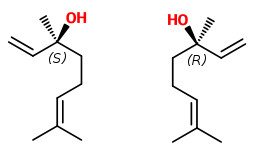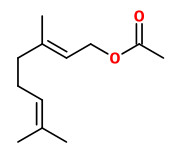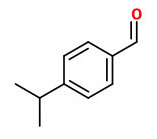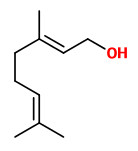Coriandrum sativum L. - Apiaceae - coriander, cilantro, cilandro, Chinese parsley, Koriander
Annual herb of Mediterranean origin, naturalized in Asia, cultivated also in Africa and Central America; 0.20-0.50 high; upper leaves bi- to tripinnate, narrow; lower leaves rounded, broad; flowers wheel-shaped, white or white-pink. Fresh leaves and the dried seeds are traditionally used in cooking.
coriander leaves
(E)-2-Alkenals like (E)-2-decenal (0.9-12.1% [odor threshold 2.7ng/l in air]), (E)-2-undecenal (1.1-5.3%), (E)-2-dodecenal (15.6-21.6%), (E)-2-tridecenal (1.8-2.5%), and (E)-2-tetradecenal (12.7-20.2%) e.g. predominated the leaf oil isolated from two commercial samples and from growth-chamber-grown plants.
[Potter, Thomas L. „Essential oil composition of cilantro.“ Journal of Agricultural and Food Chemistry 44.7 (1996): 1824-1826]
 (E)-2-dodecenal (citrus metallic waxy aldehydic)
(E)-2-dodecenal (citrus metallic waxy aldehydic)
„The essential oil of coriander leaves (Coriandrum sativum) and wild coriander leaves (Eryngium foetidum) grown in Fiji was obtained by steam distillation… The aroma profiles were characterised using gas chromatography-olfactometry (GCO) and CharmAnalysisTM. The character-impact odorants were identified using comprehensive two-dimensional gas chromatography (GC×GC) combined with time-of-flight mass spectrometry (TOFMS). During GCO analysis, the co-elution of E-2-alkenals and E-2-alken-1-ols resulted in the perception of ‘odour-clusters’. The most important odorants in C. sativum were found to be Z-2-decenal, a co-eluting odour-cluster (E-2-dodecenal, E-2-dodecen-1-ol, and 1-dodecanol), β-ionone, eugenol, and E-2-decenal. E-2-Decen-1-ol was the most abundant compound in C. sativum (26.0% TIC) but only contributed 0.39% of the total odour activity.“
[Identification of character‐impact odorants in coriander and wild coriander leaves using gas chromatography‐olfactometry (GCO) and comprehensive two‐dimensional gas chromatography–time‐of‐flight mass spectrometry (GC× GC–TOFMS)., Eyres, G., Dufour, J. P., Hallifax, G., Sotheeswaran, S., Marriott, P. J., Journal of separation science, Vol.28(9‐10), 2005, 1061-1074]
„The essential oil from leaves of Coriandrum sativum L. (Apiaceae), obtained by hydro-distillation… was dominated by aldehydes and alcohols which accounted for 56.1% and 46.3% of the oil, respectively. The major constituents were 2E-decenal (15.9%), decanal (14.3%), 2E-decen-1-ol (14.2%) and n-decanol (13.6%). Other constituents present in fairly good amounts are 2E-tridecen-1-al (6.75%), 2E-dodecenal (6.23%), dodecanal (4.36%), undecanol (3.37%), and undecanal (3.23%).“
[Chemical composition and antimicrobial activity of the essential oil of Coriandrum sativum. Matasyoh, J. C., Maiyo, Z. C., Ngure, R. M., Chepkorir, R., Food Chemistry, Vol.113(2), 2009, 526-529]
„The key aroma components in cilantro [leaves] consist of various aldehydes, in particular (E)-2-alkenals and
n-aldehydes. The saturated aldehydes (mostly decanal and dodecanal) in cilantro are described as fruity, green, and pungent; the (E)-2-alkenals (mostly (E)-2-decenal and (E)-2-dodecenal) as soapy, fatty, ‘like cilantro,’ or pungent… Through a GWAS, we have shown that a SNP, rs72921001, near a cluster of olfactory receptors is significantly associated with detecting a soapy taste to cilantro. One of the genes near this SNP encodes an olfactory receptor, OR6A2, that detects the aldehydes that may make cilantro smell soapy and thus is a compelling candidate gene for the detection of the cilantro odors that give cilantro its divisive flavor.“
[A genetic variant near olfactory receptor genes influences cilantro preference. Eriksson, N., Wu, S., Do, C. B., Kiefer, A. K., Tung, J. Y., Mountain, J. L., Francke, U., Flavour, 1(1), 2012, 22]
PDF
Major constituents of the headspace of fresh chopped coriander leaves of four cultivars commonly grown in the South Asia and Middle East were (Z)-3-hexenyl acetate (66.1-77.1%), (Z)-3-hexenol (6.0-13.1%), nonane (0.9-8.0%), 1-decanol (2.1-4.1%), (E)-2-dodecenal (1.2-2.1%), (E)-2-tetradecenal (1.3-2.2%), and dodecanal (0.4-1.5%).
[Kumar, Sunjeet, et al. „Chemical Composition of Fresh Leaves Headspace Aroma and Essential Oils of Four Coriander Cultivars.“ Frontiers in plant science 13 (2022): 168] PDF
coriander seeds
„The word coriander in food preparation may refer solely to these seeds (as a spice), rather than to the plant. The seeds have a lemony citrus flavour when crushed, due to terpenes linalool and pinene. It is described as warm, nutty, spicy, and orange-flavoured.“
http://en.wikipedia.org/wiki/Coriander
In coriander oil (S)-(+)-linalool (coriandrol) was present with 86-87%ee.
[Chiral compounds of essential oils. VIII: stereodifferentiation of linalool using multidimensional gas chromatography., Schubert, V., Mosandl, A., Phytochemical Analysis, 2(4), 1991, 171-174]

linalool stereo isomers: (S)-(+)-linalool (coriandrol: sweet, floral) and (R)-(-)-linalool (licareol: floral, woody lavender)
Coriander oils/extracts (SFE/S/SD) samples showed an (S)-linalool [(+), coriandrol)] enantiomeric excess at 85-88%ee. A commercial coriander oil presenting 81% of (S)-linalool was considered adulterated.
[Enantiomeric distribution studies of linalool and linalyl acetate. A powerful tool for authenticity control of essential oils., Casabianca, H., Graff, J.B., Faugier, V., Fleig, F., Grenier, C., Journal of high resolution chromatography, 21(2), 1998, 107-112]
The amount of total lipid is 28% of (dried) seed weight, with petroselinic acid (65%) as major fatty acid and high sterol level (5mg/g; stigmasterol, β-sitosterol, Δ5-avenasterol, and campesterol).
[Oil composition of coriander (Coriandrum sativum L.) fruit-seeds. Ramadan, M., & Mörsel, J. T., European Food Research and Technology, Vol.215(3), 2002, 204-209]
Essential oil of C.sativum seeds (EO content 0.18-0.39%) from eight regions of India were examined by GC-MS/GC-O and odour profiling was done
by trained panelists. GC-olfactometry and sensory odour analysis identified the aroma of major compounds of coriander oil and defined their characteristic odour notes with descriptors. Major descriptors of coriander aroma were floral, turpentine-like, pleasant, green, herbal, cooling, earthy, spicy, sweet and rose-like. Linalool (floral, grassy, pleasant, citrussy) as the dominant compound in all samples ranged from 56 to 75% and was followed by geranyl acetate (8.9-24.5%; pleasant, floral rose, herbal) and α-pinene (2.3-23.2%; woody, spicy, oily). Other compounds contributing to the odor profile were terpineol (0.1-5.3%; sweet, lilac), cuminal (0.1-0.5%; spicy, harsh), citronellol (0.6-1.6%; strong floral, rose, sweet), and geraniol (0.4-2.3%; fresh, sweet, rose-like). Variation in the composition of essential oil had a significant impact in sensory odour characteristics and coriander samples of different regions could be discriminated by odour profile.
[Aroma characterization of coriander (Coriandrum sativum L.) oil samples., Ravi, R., Prakash, M., Bhat, K.K., European Food research and technology, 225(3-4), 2007, 367-374]
„The essential oils composition of coriander (Coriandrum sativum L.) fruits obtained by hydrodistillation was studied at three stages of maturity by GC-FID and GC-MS. Essential oil yields showed marked increase during maturation process and forty one compounds were identified. Geranyl acetate (46.27%), linalool (10.96%), nerol (1.53%) and neral (1.42%) were the main compounds at the first stage of maturity (immature fruits). At the middle stage, linalool (76.33%), cis-dihydrocarvone (3.21%) and geranyl acetate (2.85%) were reported as the main constituents. Essential oils at the final stage of maturity (mature fruits) consist mainly on linalool (87.54%) and cis-dihydrocarvone (2.36%). Additionally, accumulation of monoterpene alcohols and ketones was observed during maturation process of coriander fruit.“
[Changes on essential oil composition of coriander (Coriandrum sativum L.) fruits during three stages of maturity. Msaada, K., Hosni, K., Taarit, M. B., Chahed, T., Kchouk, M. E., & Marzouk, B. , Food Chemistry, Vol.102(4), 2007, 1131-1134]
Linalool (73%) was the main constituent of the essential oil (yield 2.2%) of C.sativum, and (+)-linalool (coriandrol) was the predominant enantiomer (83%). Coriandrol was found to have a herbaceous and musty green smell, whereas (-)-linalool (licareol) was assigned a lavender or lily-of-the-valley odor.
[Enantiomeric distribution of some linalool containing essential oils and their biological activities. Özek, T., Tabanca, N., Demirci, F., Wedge, D. E., & Baser, K. C., Rec. Nat. Prod, Vol.4(4), 2010, 180-192]

Köhler,F.E., Medizinal Pflanzen, vol.2 t.145 (1890) plantgenera.org

Coriandrum sativum, Retiro, Colombia (2025) © hanibanani CC BY-SA 4.0 inaturalist.org





